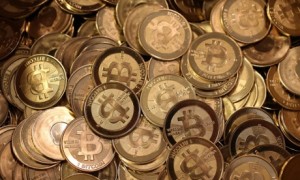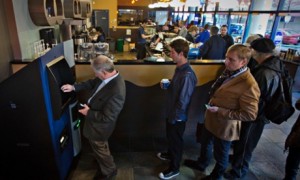Man Buys $27 of Bitcoin, Forgets about Them, Finds They’re Now Worth $886k
ECONOMICS, 4 Nov 2013
Bought in 2009, currency’s rise in value saw small investment turn into enough to buy an apartment in a wealthy area of Oslo.
Bitcoin: What You Need to Know

Norwegian man discovers $27 bitcoin investment now worth more than enough to buy an apartment. Photograph: George Frey/Getty Images
The meteoric rise in bitcoin has meant that within the space of four years, one Norwegian man’s $27 investment turned into a forgotten $886,000 windfall.
Kristoffer Koch invested 150 kroner ($26.60) in 5,000 bitcoins in 2009, after discovering them during the course of writing a thesis on encryption. He promptly forgot about them until widespread media coverage of the anonymous, decentralised, peer-to-peer digital currency in April 2013 jogged his memory.
Bitcoins are stored in encrypted wallets secured with a private key, something Koch had forgotten. After eventually working out what the password could be, Koch got a pleasant surprise:
“It said I had 5,000 bitcoins in there. Measuring that in today’s rates it’s about NOK5m ($886,000),” Koch told NRK.
Silk Road fluctuations
In April 2013, the value of bitcoin peaked at $266 before crashing to a low of $50 soon after. Since then, bitcoin has seen large fluctuations in its value, most recently following the seizure of online drugs marketplace Silk Road, plummeting before jumping $30 in one day to a high of $197 in October.
Koch exchanged one fifth of his 5,000 bitcoins, generating enough kroner to buy an apartment in Toyen, one of the Norwegian capital’s wealthier areas.
Two ways to acquire bitcoins

Customers line-up to use the world’s first ever permanent bitcoin ATM at a coffee shop in Vancouver, British Columbia. Photograph: Andy Clark/Reuters
Typically bitcoins are bought using traditional currency from a bitcoin “exchanger”, although due to strict anti-money laundering controls, the process can can be tricky. A user can then withdraw those bitcoins by sending them back to an exchanger like Mt Gox, the best known bitcoin exchange, in return for cash.
However, bitcoin is gaining more and more traction within the physical world too. It is now possible to actually spend bitcoins without exchanging them for traditional currency first in a few British pubs, including the Pembury Tavern in Hackney, London, for instance. On 29 October, the world’s first bitcoin ATM also went online in Vancouver, Canada, which scans a user’s palm before letting them buy or sell bitcoins for cash.
A small group of hardcore users also generate extra bitcoins by “mining” for them – a process that requires computers to perform the calculations needed to make the digital currency work, in exchange for a share of the built-in inflation.
Mining is a time-consuming and expensive endeavour due to the way the currency is designed. Each subsequent bitcoin mined is more complex than the previous one, requiring more computational time and therefore investment through the electricity and computer hardware required.
• In August [2013], Germany recognised bitcoin as a “unit of account“, allowing the country to tax users or creators of the digital currency.
Go to Original – theguardian.com
DISCLAIMER: The statements, views and opinions expressed in pieces republished here are solely those of the authors and do not necessarily represent those of TMS. In accordance with title 17 U.S.C. section 107, this material is distributed without profit to those who have expressed a prior interest in receiving the included information for research and educational purposes. TMS has no affiliation whatsoever with the originator of this article nor is TMS endorsed or sponsored by the originator. “GO TO ORIGINAL” links are provided as a convenience to our readers and allow for verification of authenticity. However, as originating pages are often updated by their originating host sites, the versions posted may not match the versions our readers view when clicking the “GO TO ORIGINAL” links. This site contains copyrighted material the use of which has not always been specifically authorized by the copyright owner. We are making such material available in our efforts to advance understanding of environmental, political, human rights, economic, democracy, scientific, and social justice issues, etc. We believe this constitutes a ‘fair use’ of any such copyrighted material as provided for in section 107 of the US Copyright Law. In accordance with Title 17 U.S.C. Section 107, the material on this site is distributed without profit to those who have expressed a prior interest in receiving the included information for research and educational purposes. For more information go to: http://www.law.cornell.edu/uscode/17/107.shtml. If you wish to use copyrighted material from this site for purposes of your own that go beyond ‘fair use’, you must obtain permission from the copyright owner.